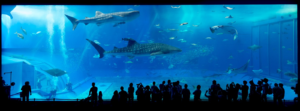Transparent displays are revolutionizing the digital signage landscape by merging the physical and digital worlds seamlessly! They display content on a transparent surface which doesn’t obstruct the view of what’s behind it. Such a novel characteristic quickly has the mind thinking of several great applications, some of which we’ll cover in more detail! It also brings inspiring potential to creativity and ambient decoration. We’ll first talk about the main benefits, use cases, and wrap up with a few tips!
Space optimization
One of the bigger benefits of transparent displays is their ability to optimize space usage. Unlike traditional displays, they don’t obstruct the view of the surroundings, allowing them to blend in and provide the appearance of a roomier environment. This space-saving characteristic allows them to work well with other elements, such as product showcases and storefront elements. This benefit becomes increasingly important when you’re low on space or you wish to make an area appear more open and roomy.
At exhibitions, conventions, or trade shows, for instance, businesses work hard to use every inch of their booth area to the maximum potential. This is one example where transparent displays may be of use!
A futuristic way of presenting information
Transparent displays offer quite a futuristic way of showcasing products to potential buyers. Retail stores, museums, or trade shows, to name a few examples, can use these displays to present information and visuals which are overlaid across other visual elements. If nothing else, they can make data appear as if floating in mid-air, immediately capturing attention. Along with drawing attention, the way this data is presented is more impactful and more likely to influence consumer behavior.
Unique product showcases
Product showcases are an excellent use case for transparent displays. Consider all the possibilities, especially with interactive or triggered content. A transparent display can be placed in front of a product, and display examples of use, additional information, pricing, and product variations, without taking up additional space or blocking the view of the product. This usage is especially important when it comes to expensive products which may be behind lock and key.
A unique in-window shopping experience
The storefront is a unique battleground where different types of content are used to draw attention and bring consumers inside your store. Transparent displays find a similar use as with the product showcases. In the storefront, they can provide additional information about eye-catching products or special offers. If that is not a viable option, any kind of content that plays mid-air in the storefront window will surely catch attention! As we always say, it’s up to you to ensure the content is compelling, as the attention-grabbing power is only one piece of the puzzle for success.
Digital signage art
Let’s briefly put aside promotions and sales and instead focus solely on the visual impact of transparent displays. They’re a marvel to look at and you can focus entirely on that benefit by utilizing them for decorative purposes. Use transparent displays as a canvas for digital signage art, adding a special touch to the interior ambiance of your business. This art can be simple designs that fit with your interior theme. Or you can reach out to local artists and build upon the bond with your community by showcasing artwork which matches your brand style. Of course, it all depends on the context and your goals, but it’s worth considering!
Additional information on-demand
As you have now seen, product showcases are a great example where transparent displays may provide additional information about a product. This benefit also extends to the consumer experience as a whole in other fields. Establishments which do exhibits, for instance, can utilize the benefits of transparent displays to provide all sorts of data, ranging from historical information about museum pieces to the family tree of a species in an aquarium or a zoo. In these places, there are plenty of instances where visitors look at things through a glass barrier. Transparent displays can add an extra layer to the experience by seamlessly incorporating additional information.
A few important tips!
Keep transparent displays clean, especially the interactive ones. Smudges and fingerprints can impact the visibility and the overall experience, impairing the benefit of having a transparent display in the first place.
Consider the lighting conditions surrounding the transparent display as they can affect them. For instance, varying levels of light, both natural and artificial, can make them appear different.
Contrast is very important as the content on display needs to be visually separate from the background.
Layer content over existing elements such as text, graphics, images, as well as the aforementioned product showcases, etc.
Display unexpected visuals by placing transparent displays where they’re not expected. Show a transparent menu in a restaurant or greet visitors with triggered messages which surprise them as they enter. Show floating decorations or even use these displays to deploy animated brand information, logos, and other visual nuggets that appear to be floating in mid-air.






